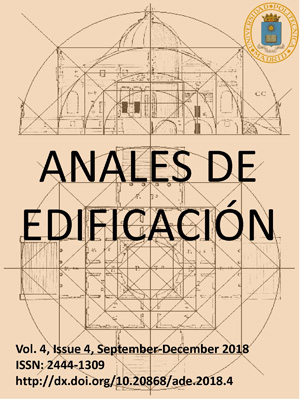Variación cromática del color azul en maderas de construcción europeas por la aplicación superficial con ácidos = Chromatic variation of blue colour on European construction timbers by surface application with acids
DOI:
https://doi.org/10.20868/ade.2018.3847Palabras clave:
Modelo predictivo, Variación cromática superficial, Madera de construcción, Ácido, Predictive model, Surface chromatic variation, Timber, AcidResumen
Resumen.
La variación cromática de la superficie de las maderas de construcción, mediante la aplicación controlada superficial de ácidos incoloros en estado líquido permite establecer un modelo predictivo entre las maderas ensayadas y las maderas no ensayadas en esta investigación. El modelo predictivo obtenido está basado en ábacos, ordenados por ácidos, maderas y el color azul (porque es el color con mayor porcentaje de variación cromática superficial comparado con los colores rojo ó verde), lo cual permite predecir el comportamiento del porcentaje de variación cromática superficial de maderas y ácidos no ensayados en esta investigación, comparándolos de acuerdo con su clasificación, densidad, especies, origen, color, fuerza y división con siete maderas de construcción europeas y quince ácidos que han sido ensayados. La metodología usada define los parámetros de elección de los materiales escogidos y el método de realización de la variación cromática de las maderas de construcción, presentando y ordenando los resultados obtenidos de variación del color azul en una tabla.
Abstract.
The chromatic variation of the surface of construction timber, by means of the controlled surface application of colorless acids in liquid state allows to establish a predictive model between timbers tested and not tested in this research. The predictive model obtained is based on an abacus, ordered by acids, timbers and blue color (because is the color with the greatest percentage of surface chromatic variation compared to red or green colors), which allows to predict the behavior of the percentage of surface chromatic variation of timbers and acids not tested in this research, comparing them according to their classification, density, species, origin, colour, strength and division with seven European construction timbers and fifteen acids that have been tested. The methodology used defines the parameters of choice of the materials chosen and the method of production of chromatic variation of construction timbers, presenting and ordering the results of variation of the blue color obtained in a table.
Descargas
Referencias
Aeim. (2017). Commercial and Construction timbers. Spanish Association of the trade and industry of the wood. Spain.
Aristizábal, D.L. & Ramírez, C.A. (2006). Conceptos básicos del procesamiento digital de imágenes usando Orquidea Jai. Escuela de física. Universidad nacional de Colombia. Sede Medellín. Colombia.
Boonstra, B., Rijsdijk, J., Sander, C., Kegel, E., Tjeerdsma, B., Militz, H., Van Acker, J., Stevens, M. (2006b). Microstructural and physical aspects of heat treated timber. part 1. Softtimber. Maderas. Ciencia y Tecnología 8 (3): 193-208.
Coronado, J., García, A. (2010). La influencia de los productos hidrofugantes en las modificaciones cromáticas del ladrillo cerámico. Materiales de construcción. 61(304): 597-611.
Garayl, R., Inostroza, M., Ducaud, A. (2017). Colour and gloss evaluation in decorative stain applied to cases of pinus radiata timber treated with copper azole micronized type c. Maderas Ciencia y Tecnologia. 19(1): 21-38.
García, A., Conci, M.(2005). Variación del color del soporte cerámico tratado con barniz antigraffiti. Materiales de construcción 55(278): 55-68.
Gómez, W. (2015). Análisis de imágenes digitales. Mejoramiento de la imagen. Procesamiento de histogramas. Diapositivas de curso.
Kauppinen, Hannu. (1999). Development of a colour machine vision method for Wood Surface Inspection. Ph.D. Thesis. Department of Electrical Engineering and Infotech Oulu, Oulu.
Mauro, F., Balarezo, R. (2014). Retardantes de llama (parte 2). rif.nº v-13310614-2. Registro inpsasel: 07 13310614.
MCcurdy, M., Shusheng, R. (2005). Measurements of color development in pinus radiate sapwood boards during drying at varios schedules. Maderas: Ciencia y Tecnologia. 7(2): 79-85.
Novoa, L.A. (2006). Programa de desarrollo de políticas de comercio exterior 1442/oc –pe. Consultoría de secado y preservación de madera aserrada. Manual de buenas prácticas de manufactura para la preservación de madera aserrada; acorde a los estándares expresados en las propuestas de normas. Mincetur. Banco interamericano de desarrollo.
Özçifçi, A., Uysal, B., Kurt, S & Özbay, G. (2009). Impact of various fire retardants on the red colour and yellow colour tone of some woods and varnishes. Karabuk University. Technology, 12(4): 267-274.
Petric, M. (2013). Surface modification of wood: a critical review. University of Ljubljana. Scrivener publishing llc.
Rodriguez, A., García, A. (2010). The classification, characterizacion and crhomatic descomposition analisys of clourless varnishes, applied to wood used in construction. Congreso IAHS. Santander. Spain.
Rodriguez, A. (2012). Influencias de los barnices incoloros en las propiedades superficiales de las maderas de construcción. Ph.D.Thesis, UPM, Madrid, Spain.
Sandoval, S., Torres., Wahbi, J., Oise F., Marc., Puiggali, J.R. (2012). Colour alteration and chemistry changes in oak timber (quercus pedunculata ehrh) during plain vacuum drying. Timber sci technol, 46:177–191.
Sundqvist, Bror. (2002). Colour response of scots pine (pinus sylvestris), norway spruce (picea abies) and birch (betula pubescens) subjected to heat treatment in capillary phase. Holz Roh- Werkst 60:106–114.
Villegas, MS. (2009). Colorimetría y blancura en madera de salix. Jtp dendrología. Facultad de ciencias agrarias y forestales, U.N.L.P., CC. (31): 1900. La Plata. Argentina.
Descargas
Publicado
Número
Sección
Licencia
1. Los autores conservan los derechos de autor y garantizan a la revista el derecho de una Licencia Creative Commons Atribución - Nocomercial 4.0 Internacional que permite a otros compartir el trabajo con un reconocimiento de la autoría y uso no comercial.
2. Los autores pueden establecer por separado acuerdos adicionales para la distribución no exclusiva de la versión de la obra publicada en la revista (por ejemplo, situarlo en un repositorio institucional o publicarlo en un libro).
Salvo indicación contraria, todos los contenidos de la edición electrónica se distribuyen bajo una licencia de uso y distribución “Creative Commons"












